Google’s web crawlers are constantly searching the internet for new and updated web pages.
When these crawlers index a site’s content, they don’t just use the information to deliver search results. They make a backup of the pages and add them to a unified database called Google Cache.
You might have used Google Cache to view old versions of websites that are down or not loading correctly. But did you know that you can also use it to solve problems on your website? It can even help with your SEO efforts.
This article introduces Google Cache and how to check it. We’ll also look at how Google Cache is helpful — and when you shouldn’t rely on it too much.
Check Out Our Video Guide to Google Cache
What Is Google Cache?
A Google cached page is a raw HTML backup of the content on a page taken during one of Google’s crawls. Google Cache as a whole comprises these backed-up pages.
If you look at the cached version of your website, it’ll probably look a lot like the site did back when it was crawled. But there are a few reasons it sometimes appears different than you expect.
Two main reasons are:
- The web page is rendered by your browser, not by Google. This can cause discrepancies with the current version of the site.
- JavaScript isn’t saved to the cache, so parts of your website might be missing.
What Does a Google Cached Page Look Like?
At the top of a cached page, you’ll see a banner showing you three things:
- The URL of the cached page — This will usually be the URL you meant to visit. In some cases, like a redirected URL, it will be different.
- The date this version of the page was cached — You can see if the cached page you’re looking at was created yesterday or last week. This isn’t necessarily the last time your web page was crawled; we’ll get to that in a bit.
- Versions — You can select to view the full version, the text-only version, or the source of your page. The full version shows you the page as rendered by your browser. The text-only version has CSS turned off and no images displayed, but you’ll still see hyperlinks. Clicking on View source shows you the page’s source code:
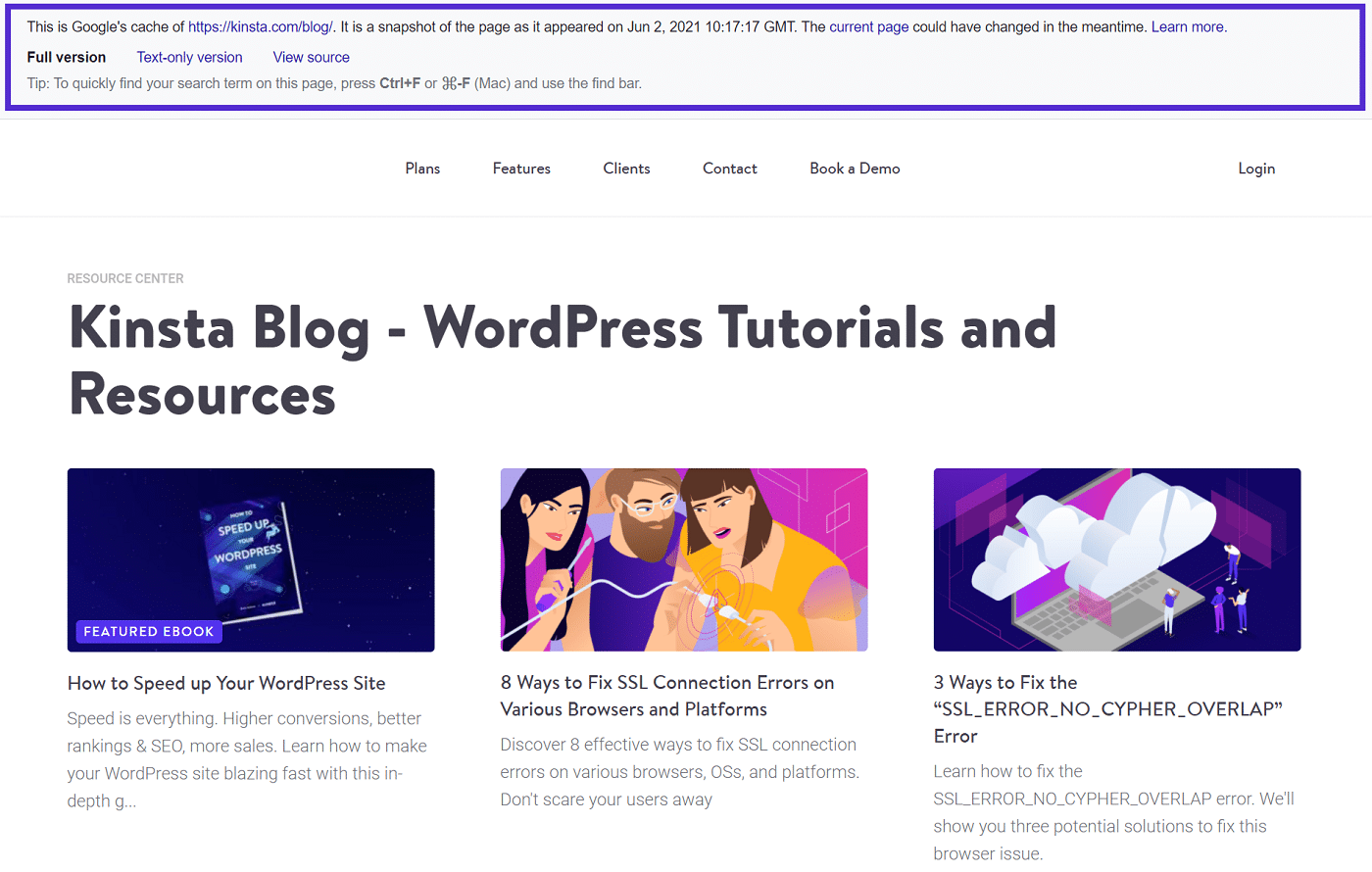
Why Google Cache Is Important
The primary use of Google Cache is for people browsing the internet. It allows them to see web pages that are down or having problems loading.
As a website owner, there are other reasons that Google Cache is crucial. You hope your site will never go down or have glitches, but it happens. Having a cache makes your content available to users, even if something’s not working right.
You can also use your site’s cached version to learn about how your site is indexed and diagnose problems. Read on to learn more.
How to View Google Cache?
How you go about getting to a cached Google page from the Google search engine results will depend on what type of device you’re using. From a desktop web browser, you have two options:
- You can follow a link to the cached version of a page from the Google search results.
- You can go directly to the page.
On mobile browsers, you only have the option to use the direct URL.
Viewing a Cached Page From Google Search Results
Even if you have experience viewing cached sites from the search results page, you might want to read this because Google changed the way to find a cached link in early 2021.
To start, search for the page you want to see on Google. Next to the page’s URL in the search results, you should see three vertical dots. Click them, and a pop-up window should appear labeled “About this result”:
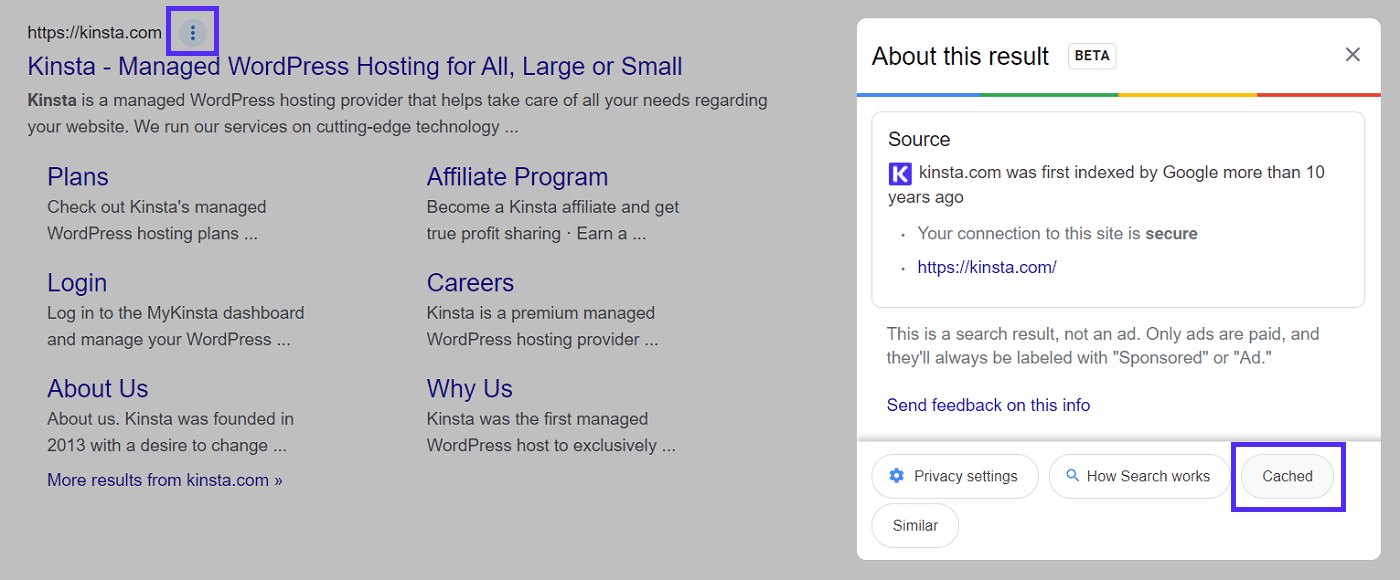
This feature is currently in beta. It’s meant to let you learn more about a site (like whether it’s safe) before clicking.
At the lower right of the pop-up, there’s a button labeled Cached. Click it to see the cached page.
In some cases, you might not see a Cached button. That could mean the page hasn’t been cached; we’ll talk about what that means in a bit.
But if you’re on mobile, you won’t see the button for any page. In that case, keep reading to learn the other method of viewing a cached page.
Modifying the URL to View the Cached Page
For this method, you have to know the URL of the page you want to see. Just enter cache:website.xyz into the search bar.
For example, cache:kinsta.com will take you right to our cached homepage.
Other Tools for Viewing Google Cache
You don’t need any special tools to view cached pages; Google makes it extremely easy natively. But there are a few tools out there with features you might like.
The Web Cache Viewer extension for Chrome lets you right-click any link to see both the Google Cache version and the Wayback Machine web archive version of the page.
And the Google Cache Checker from Small SEO Tools lets you view the URLs and dates cached for up to five pages at once:
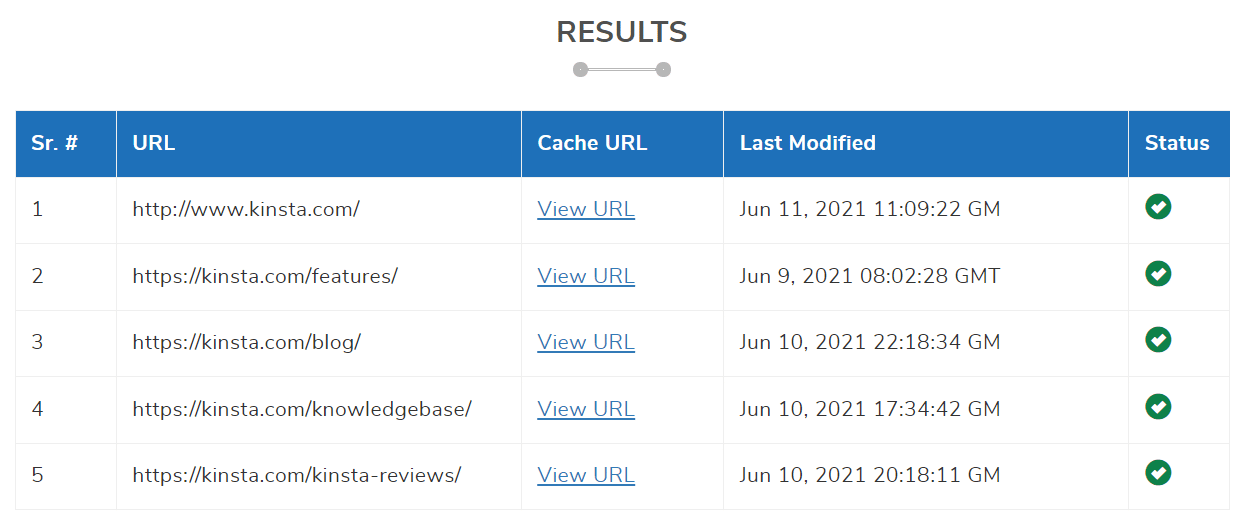
Viewing Older Versions of a Page With Google Cache
Your page says it was cached yesterday, but you want to see the version from last week. Is it possible with Google Cache?
Unfortunately, no.
Google can only show you a single version of a cached page. To see previous website versions, you can use a tool like the Wayback Machine, an archive of past versions of web pages.
Check out what we used to look like!

Reasons To Use Google Cache as a Website Owner
The truth is, there are other tools available to accomplish everything below — in many cases, more sophisticated tools.
But Google Cache is hard to beat for being quick and easy to check. That makes it a valuable way to monitor certain aspects of your web pages.
Here are five ways you can use Google Cache as a site owner.
1. Check for Duplicate Content
Sometimes you click on a cached link and land on a different page than you expected.
One reason this can happen is due to duplicate content. When Google sees two highly similar pages, it may decide not to keep them separate in the index. This results in only one being kept in the cache.
Google caching multiple pages under the same link can alert you that you have duplicate content on your site. Duplicate content doesn’t just create a confusing cache situation — it’s bad for SEO.
Please take the opportunity to examine the two pages and find a way to differentiate them.
2. Verify That Google Respects Your Canonical Tags
Maybe the duplicate content on your website is intentional, but you’ve added rel=canonical tags to tell Google which version to crawl.
Check the Google Cache version of one of the pages you don’t want to have crawled. You should be taken to a cache of the canonical page.
3. Make Sure Your Marketing Efforts Have Been Crawled
You’ve ramped up your SEO or content production efforts, and you want to make sure Google is indexing the changes.
A quick look at the cached version of a page can tell you that it’s been crawled.
Note that if your changes haven’t appeared on the cached page, they may still have been indexed. If you’re concerned, you can go to Google Search Console’s URL Inspector to confirm. But if you see your updates on the cache, you know they’ve been indexed and will start to impact your search result rankings.
4. Keep an Eye on Changes to Competitor Sites
You mind your own business, enjoying your position at the top of the search results for a critical keyword when a competitor takes your spot out of the blue. What did they do to get there? You can use Google Cache to find out. Compare their cached pages to the current versions — you’ll be able to see what recent changes the competitor made.
5. Retrieve a Recent Version of Your Site
You should always have a backup of your website in case something happens to it. That said, sometimes the worst can come to pass, even with the most prepared individual.
While the Google Cache version of your site doesn’t replace a full backup, it does sometimes let you see what your pages looked like before disaster struck. You can use it to retrieve old content or code that’s been lost.
Limitations of Google Cache
Google’s cache can provide helpful information, and it can be worth investigating if something looks strange. But Google Cache has some known limitations.
Google Cache Won’t Tell You When Your Page Was Last Crawled
Let’s start with one of the biggest misconceptions.
A lot of people believe that the cache is updated every time Googlebot crawls a page. Plenty of other articles on this subject will tell you to use the cache to see how frequently your page is crawled.
It’s not true.
We know that because John Mueller of Google told us so himself in a help thread, saying:
“In general, we do not always update the cached page every time that we crawl a page. Especially when the page does not significantly change, we may opt to just keeping [sic] the old date on it.”
Here’s a pro tip: If you’re looking for information on how often, why, and with which bots Google crawls your website, forget about the cache. That data is on Google Search Console. You can find the crawl report under Settings in the sidebar.
However, you can only see this information at the domain level. Search Console won’t tell you how often each page is crawled.
The Page May Not Be Rendered Properly
Fortunately, some progress has been made on this front. Google’s Web Rendering Service, which renders live pages on the web, used to be based on an outdated version of Chrome. Consequently, up-to-date browsers sometimes rendered a cached page differently than Google rendered the current page.
Since 2019, Google Web Rendering Service uses the latest version of Chrome.
However, if your Chrome version is old, or if you’re using a different browser, the cached page might be rendered improperly.
Another rendering issue has to do with missing resources. The code that Google backs up might refer to a resource like CSS or JavaScript. If those resources no longer exist or have changed, the page won’t render correctly.
The Wrong Page Is Displayed
We’ve already looked at how duplicate content or incorrect canonical tags can lead Google Cache to display the wrong page. As you might imagine, this limits the usefulness of looking at the cache for specific web pages.
Some Pages Are Not Cached
This may come as a surprise, but it turns out that many pages aren’t cached at all.
A widespread misconception is that an uncached website means that Google hasn’t deemed it essential, but that’s not necessarily true. We’ll look at some reasons a page might not be cached next.
Why Can’t I Find My Cached Webpage?
Not all pages that are crawled are cached. If your page is without a cached version, don’t panic! It doesn’t mean that your page hasn’t been indexed.
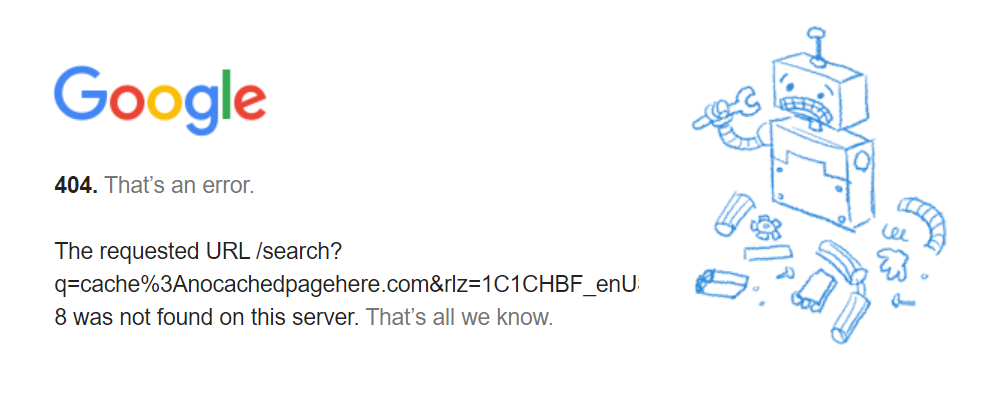
If you’re concerned that it truly hasn’t been indexed, you can use Google Search Console’s URL Inspector to check.
For proof that indexed pages aren’t always cached, we go back to Google’s John Mueller. On Twitter, he responded to a user asking about an uncached page:
“We don’t cache all pages that we index, so that can happen. Sometimes it takes a while, sometimes we just don’t cache it at all.”
And when the user asked him if uncached sites were always low-quality, he said:
“That + it can be all kinds of pages for weird technical quirks. The cache is kinda separate, so it’s not indicative of what we index & rank.”
In other words, cached pages aren’t a ranking factor. You can make it to the top of the search results even if your web pages don’t have cached versions.
But an uncached page still might be worth looking into. There are a few different possibilities you can explore.
Your Page Is JavaScript-Based
Google has an easier time indexing some JavaScript-powered pages than others. But many JavaScript pages end up uncached or even unindexed.
That’s because most of the HTML isn’t loaded until after JavaScript executes. If nothing is there to index, Google won’t create a cached page.
Caching Is Prevented by a Meta Tag
A noindex meta tag in your page’s HTML code means the page can’t be indexed by Google, while noarchive prevents it from being cached. Either one will result in an uncached page.
Maybe that’s precisely what you want. But if you didn’t realize you had a noindex or noarchive tag on the page, removing it can solve your missing cache problem.
The Page Is a Duplicate (or Google Thinks It Is)
If Google has decided that two of your pages are duplicates, find ways to make them unique. Consider the different search intents for each page.
How to Fix Problems With Your Website’s Cached Pages
Your page doesn’t have to get cached, but if you want to make it happen, there are some things you can do.
Submit Your Page to Google
If you’re concerned that Google hasn’t indexed your page at all, you can check Google Search Console.
Enter the page’s URL in the URL inspection search bar at the top of Search Console. If you get the result “URL is on Google,” the page has been indexed. If the page has changed recently and you don’t think Google has indexed the new version, you can click Request Indexing to ask Google to re-index it.
You might also get the result “Page is not on Google.” If you do, scroll down, and you’ll be able to see some details about the page. For example, you can check if crawling is allowed on that page and whether the user-chosen canonical matches Google’s chosen canonical. To request indexing, click Request Indexing:

Check for Common Site Issues
We’ve already covered several reasons your pages might not be cached, like extensive JavaScript and duplicate content.
Beyond that, the best thing you can do to encourage frequent indexing is to create a high-quality site. Make sure you’ve optimized your website for mobile and that your site speed is high.
If your page load time is too slow, it can even slow down Google’s bots, leading to delayed indexing.
How to Remove Pages From Google Cache?
We think Google Cache is quite useful, but you might not want an old version of your web page stored on Google’s servers for various reasons. For example, maybe you don’t wish pages for discontinued products to be available.
One way to prevent the caching of your pages is with noindex and noarchive tags mentioned above. These tags are the ideal permanent solution if you want to keep the pages but never want them to be cached.
You can also ask Google directly to remove URLs from Google Cache. To do so, go to Google Search Console and click Removals in the sidebar. Then click on New Request. At this point, you have two options: Temporarily Remove URL and Clear Cached URL.
Temporary removal means that the URL won’t appear in Google search results for around six months. The cache will disappear as well. The page will be re-indexed and re-cached when it’s live again (if you don’t want that to happen, you’ll have to add a meta tag).
Clearing the cached URL is exactly what it sounds like. The cache will be removed, but the page will be cached again when the site is crawled.
If you want an old version of an updated page to disappear, this is an excellent way to do it. You can also push Google to update your page’s cache by submitting the page for indexing after you’ve changed it.
Summary
Google Cache isn’t everything it’s rumored to be. You can’t use it to check when your website was last crawled — having it doesn’t improve your search engine rankings. And sometimes, its stored version of your site is weird, incomplete, or just plain wrong.
But Google Cache has its uses for website owners. It’s a quick way to check how your site was indexed, and it can help you notice and diagnose problems. You can also use Google Search Console to improve your search engine rankings.
Do you have any questions left about Google Cache? Let us know in the comments section — we want to hear them!


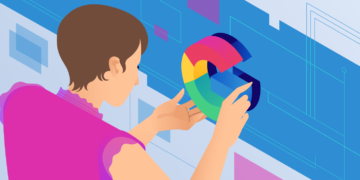
Leave a Reply